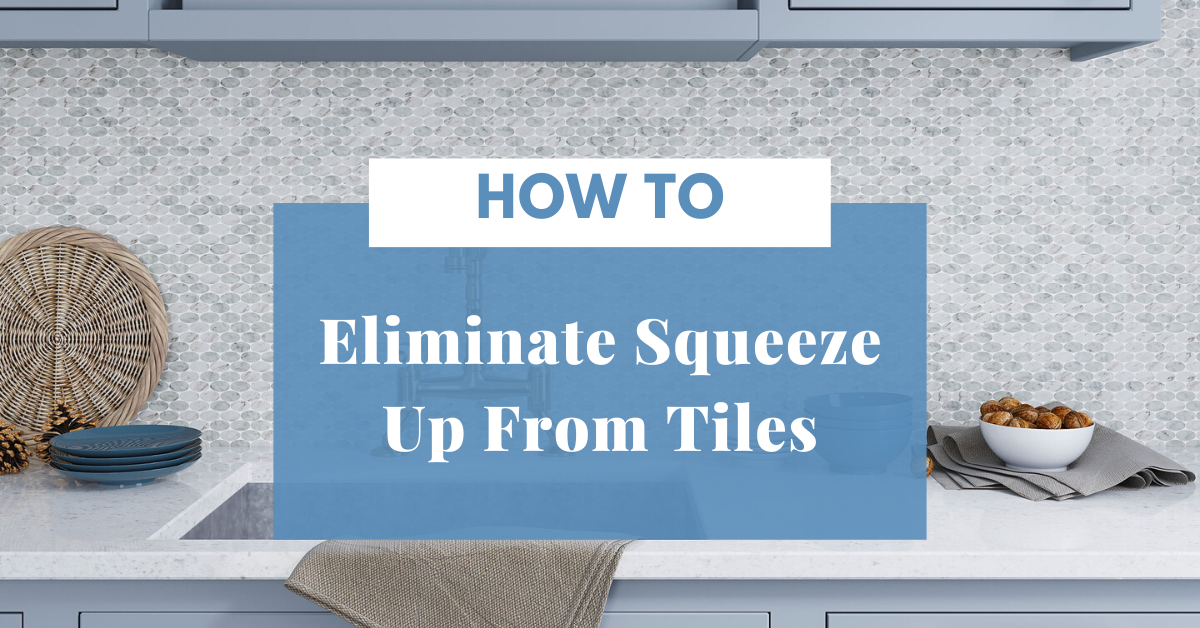
How To Eliminate Squeeze Up During Tile Installation
|
|
Time to read 4 min
|
|
Time to read 4 min
When it comes to the tile installation process, there can be a few hiccups along the way. There’s a large amount of precision and care that goes into the process overall, but especially when it comes to the thin set mortar and grout. While we can likely all agree that the outcome of tiling is something for the books, there may be a few obstacles on our path to finishing the last few chapters.
When installed correctly, eliminating tile squeeze, the result is seamless beauty as seen in this bathroom backsplash featuring our Wooden Grey Fan Marble Mosaic Tile.
One issue in particular? Squeeze up from tiles. This is a common problem even the pros face, and today we’re going to review how to eliminate squeeze up from your tile installation so you can sail smoothly into your next DIY project.
'Squeeze up' is an industry phrase that essentially means thin set mortar that creeps up between tile joints. This happens when you apply the thin set mortar, and lay your tiles. The mortar has the opportunity to rise up, and go in between your tile joints. The result is a less-than-seamless experience when it comes time to grout your tiles and finish the job. In the long term, it can lead to gaps in the tile joints as well as cracking. Yikes!
As mentioned earlier, setting tiles can be a challenging and time-consuming task, but the results can be truly stunning.
There are a few tips and tricks you can use to minimize the negative effects of tile squeeze up, eliminating it completely.
Squeeze up issues can be especially troublesome when installing mosaic tiles. Read on to find out how you can achieve a seamless look like this backsplash using our 4 Inch White Carrara Hexagon Honed mosaic tiles.
You would think if squeeze up is to be eliminated, the use of a smaller trowel would be the best choice. Many times, this trowel of choice is a 5/32” or 3/16” “Vee” notch, but perhaps to the surprise of most of us, this isn’t the ideal size to use to solve the problem of squeeze up.
The “Vee notch” trowel provides about 8 to 12 percent mortar coverage on the back of the tile, but many times, these mosaics are installed in wet areas, which require a minimum mortar coverage of 95 percent.
That leads us into how to go about finding the right size trowel for the job.
For most mosaic projects, a ¼” x ¼” x ¼” trowel will provide full coverage with no squeeze up. This size trowel is also relatively easy to control, making it a good choice for beginners.
Note: When it comes to thicker mosaics, a ¼” x 3/8” x ¼” trowel may be necessary. You will need to judge and make the call.
Overall, the important thing is to choose a trowel that will provide full coverage without requiring too much effort. With the right tools, setting tiles can be an enjoyable and rewarding experience. We promise!
When installing the mosaic or traditional tile, there are a few things to keep in mind for preparation:
By following these steps, you can be sure that your tile installation will be successful.
Installing backsplash tiles using these tips will help you achieve a seamless appearance as seen here with our Azul Cielo Thassos And Carrara Striped Chevron Mosaic Tile.
Not one to try out a new trowel size? That’s just fine.
Another, potentially easier option for you, is to rid the thin set mortar creep through scraping away the excess between the joints. This is particularly useful if you plan to complete the tile job over the course of a weekend vs. one day.
In order to do this concept, you’ll need the following tools:
Once you have these items, here’s what you will do:
Don't let the possibility of a little mess keep you from installing the tile of your dreams! Just take a look at this stunning kitchen island using our Carrara Chic With Thassos Dots marble mosaic tile!
So, what have we learned? First and foremost, that tile installation can be a tricky process but with the correct technique and tools, you'll be on your way to an easy install. Secondly, that squeeze up from tiles can cause all sorts of problems - chief among them being an unsightly finished product. But don't worry! Use this blog to achieve the best ways to help you eliminate this pesky issue and finish your project flawlessly.
With the right tools, knowledge, and attitude towards DIY projects, anyone can install beautiful tiles like a pro. What are you waiting for? Start browsing our selection of beautiful tiles today!





